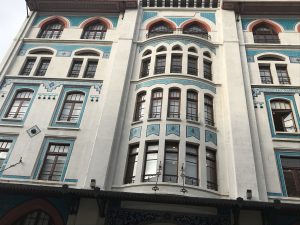“In front of the Judge”
 The waterfront neighbourhood of Eminönü is always frantically busy with passengers boarding ferries of the tram. Just inland it’s dominated by the imposing Yeni Cami (New Mosque), with its twin minarets and multiple domes, that completely dwarfs the unexpectedly petite Mısr Çarşısı (Egyptian or Spice Market) beside it. Much of the space in front of the two buildings is filled by a large square, once a bus terminal, that makes it possible for visitors to glimpse the battered Byzantine and Ottoman buildings forming part of the adjacebt Tahtakale bazaar area. The area immediately in front of the mosque is a popular place for feeding pigeons, birds much loved by many Muslims.
The waterfront neighbourhood of Eminönü is always frantically busy with passengers boarding ferries of the tram. Just inland it’s dominated by the imposing Yeni Cami (New Mosque), with its twin minarets and multiple domes, that completely dwarfs the unexpectedly petite Mısr Çarşısı (Egyptian or Spice Market) beside it. Much of the space in front of the two buildings is filled by a large square, once a bus terminal, that makes it possible for visitors to glimpse the battered Byzantine and Ottoman buildings forming part of the adjacebt Tahtakale bazaar area. The area immediately in front of the mosque is a popular place for feeding pigeons, birds much loved by many Muslims.
The roads behind the Mısr Çarşisı wind uphill to the Kapalı Çarşı (Grand Bazaar); behind the mosque they lead to Sirkeci and then on to Gülhane and Sultanahmet. Eminönü is also linked to trendier Karaköy by the Galata Bridge, a much rebuilt structure well-known for the anglers who can be seen dangling their lines over its sides at all times of day or night.
Between them the Yeni Cami and the Mısr Çarşısı soak up most of the attention. But the back streets of Eminönü are well worth a look because here, unlike in Beyoğlu where European architectural styles reigned supreme, you can see the indigenous Turkish First National style of architecture battling it out for supremacy with imported Neoclassicism and Art Nouveau in a series of virtually ignored 19th and early 10th-century hans.
 Yeni Cami
Yeni Cami
Although it is not immediately obvious, the prominent Yeni Cami (New Mosque) forms part of a külliye (mosque complex) with the Mısr Çarşısı (Egyptian or Spice Market), the tomb of Hatice Turhan Sultan and the magnificent sebil (public fountain) nearby. It was a complex many years in the making. Sinan’s pupil, Davud Ağa, originally began work on the mosque in 1597 but work stopped when Sultan Mehmed IV died and the building was not completed until 1663 by which time the architect in charge was Mustafa Ağa. The mosque reopened to visitors after complete restoration in 2022.

A massive pile, the Yeni Cami follows a plan that will be familiar to those who’ve visited the Sultanahmet Cami (Blue Mosque) or the Süleymaniye. Steps lead up to the main entrance which opens onto a wonderful courtyard surrounded by porticoes and centred on a şadırvan (ablutions fountain) which in turn opens onto the mosque itself, a huge space beneath a soaring dome. To the rear men can usually be seen washing their feet at a row of fountains beneath the portico of the son cemaat area.
To the rear you’ll find the small muvakkithane, the time-keeper’s cottage where the precise times of prayer would be calculated. Here too you’ll see an ancillary building that slopes up towards the mosque, then turns left to connect with it providing an arch beneath which walkers can get to the shore. This was the hünkar kasrı where the sultan and his family could rest before and after visiting the mosque. The walls of the two lovely rooms and the corridors inside it are all covered with İznik tiles. It is sometimes open to visitors during Ramazan or for temporary exhibitions.
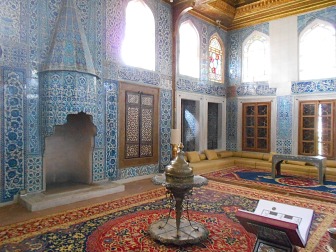
The large mausoleum facing the muvakkithane was originally built for Hatice Turhan Sultan, the mother of Sultan Mehmed IV and effective ruler of the empire during his childhood (he became sultan when aged only seven). The tombs of Sultans Mustafa II, Ahmed III, Mahmud I and Osman III can be seen beside that of Mehmed IV in a building that has been completely restored. Just steps away from it there is also a magnificent sebil, a staffed drinks dispensary, that is also part of the complex. Damaged in a fire in the late 19th century, it was restored by Osman Hamdi Bey, although sadly no one staffs the booth any more.
Spice Market
 Built in the 1660s as part of the New Mosque complex, the multi-domed Spice Market was called the Egyptian Market because it sat at the end of a trade route that brought goods from the Far East via Egypt to Turkey. Even today a few of the small booths inside it still sell spices and herbs as well as dried fruit, caviar and a variety of flavoured teas although a growing number sell goods unashamedly aimed at a tourist clientele.
Built in the 1660s as part of the New Mosque complex, the multi-domed Spice Market was called the Egyptian Market because it sat at the end of a trade route that brought goods from the Far East via Egypt to Turkey. Even today a few of the small booths inside it still sell spices and herbs as well as dried fruit, caviar and a variety of flavoured teas although a growing number sell goods unashamedly aimed at a tourist clientele.
There are four entrances to the bazaar although most people enter through the one facing the Galata Bridge above which sits the Pandeli Restaurant. Inside the side entrance from Tahtakale you’ll see what looks like a raised wooden cabinet but which used to be where the imam would lead morning prayers before work began in the bazaar.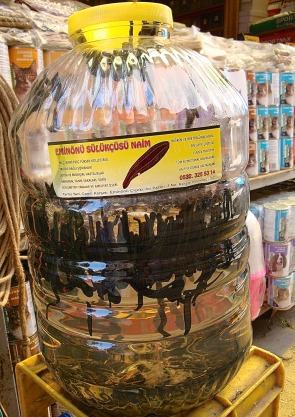 Leech anyone?
Leech anyone?
Locals tend to be more interested in the items on sale on either side of the building. On the Yeni Cami side booths sell plants, pets and leeches (used for medicinal purposes) while on the Tahtakale side they major on fruit, vegetables, cheese and meat. Behind the market yet more stalls sell kitchenware and a multitude of other mundane household items.
Along Hamidiye Caddesi from Sirkeci to Eminönü
As you walk from Sirkeci towards the Yeni Cami glance to the right and you will see on the side of the Doğubank electrical store a colourful mosaic by the great artist Bedri Rami Eyüboğlu. Shortly afterwards you will pass the tomb of Sultan Abdülhamid I. Beautifully restored, it is open to the public who will find the grave of Sultan Mustafa IV there too. The calligraphic tiles ringing the walls are especially beautiful and the holy relics encased in the wall ensure a steady throughput of pilgrims.
 Across the road is the stupendous building that houses the Legacy Ottoman Hotel. Hard though it may be to believe it, it started life as a humble han, the Fourth Vakıf Han, designed in the 1910s by Kemaleddin Bey, the second mover behind First National Architecture; his “signature” can be seen on the corner where the han joins the Sansaryan Hanı, designed in 1895 by the Armenian architect Hovzep Aznavour (1854–1935). This used to house the İstanbul courthouse which has now been moved to Çağlayan.
Across the road is the stupendous building that houses the Legacy Ottoman Hotel. Hard though it may be to believe it, it started life as a humble han, the Fourth Vakıf Han, designed in the 1910s by Kemaleddin Bey, the second mover behind First National Architecture; his “signature” can be seen on the corner where the han joins the Sansaryan Hanı, designed in 1895 by the Armenian architect Hovzep Aznavour (1854–1935). This used to house the İstanbul courthouse which has now been moved to Çağlayan.
On nearby Yalıköşkü Caddesi you’ll find the Liman Han, another work of Vedat Tek dating back to 1907, its facade papered with exquisite azure and turquoise tiles. The top-floor restaurant has a fine view over the waterfront. It’s the loveliest of all the local buildings to have been given new life in the early 21st century.
As you near the Yeni Cami you will see on the left a stately building that started life in 1898 as a post office and then became a branch of the Türkiye Iş Bankası. Today it houses the unexpectedly state-of-the-art Türkiye İş Bankası Museum (admission free, closed Mondays) which gives visitors a chance to admire its beautifully restored interior.
The main displays on banking history are of fairly specialist interest but children will love the basement where you pass through huge metal doors to access the bank vaults. Here streams of numbers flow like water down the corridor and the private cashboxes are open-sided to let visitors peep in on the sometimes surprising items that individuals valued highly enough to pay to protect.
Along Büyük Postane Caddesi
If instead you walk from Sirkecu along Büyk Postane Caddesi you will come to the namesake Büyük Postane (Main Post Office), a magnificent building designed between 1905 and 1909 by Vedat Tek, one of the leading lights in the movement known as First National Architecture that brought together elements of Selçuk and Ottoman style to create something distinctively new. Part of the post office houses a small museum (admission free, closed Saturdays and Sundays) of rather specialist interest (philatelists will love it) but a visit to it gives you a chance to appreciate the wonderful stairwells and ceilings that were designed for official buildings in the early 20th century. Only a small part of the post office still handles the mail, sadly.
From the steps of the post office you’ll see to your right the lovely Vlora Han, an Art Nouveau masterpiece, probably designed by Giulio Mongeri. Despite the all-encompassing grime you can hardly fail to be impressed by the delicate stone roses adorning it and by the elaborate wrought-iron windows and balconies. It’s long overdue for restoration.
Immediately facing the Büyük Postane another han has been cleaned up and reoccupied; turn down Hamidiye Türbesi Sokak beside it to see an arched entrance leading into an old-fashioned han courtyard that is currently being restored. A little further down Büyük Postane Caddesi the huge building that once housed the Sümer Bank has also been cleaned up and now houses a shop specialising in honey products.
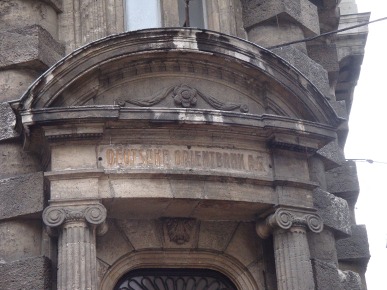 On the corner diagonally across from it an austere building designed in 1890 to house the Deutsche Bank by the German architect August Jasmund (1863-1915) has been turned into the Orientbank Hotel.
On the corner diagonally across from it an austere building designed in 1890 to house the Deutsche Bank by the German architect August Jasmund (1863-1915) has been turned into the Orientbank Hotel.
If you walk beside it up Fındıkçı Remzi Sokak beside it you will see in front of you the Katırcıoğlu Hanı, a capacious building housing the Perdeciler Çarşısı (Curtain-Sellers Market) and decorated with long, colourful mosaics by Yusuf Gürün that tell the story of kilims right through from the sheep that provided the wool to the women who worked the looms to produce the final product.
If you walk through the han to the far side and turn left down the steps you’ll arrive in Aşırefendi Caddesi, which is lined with magnificent 19th-century hans by a mixture of Armenian and Greek architects, including Konstantinos Kyriakidis (1881-1942). Most were designed in neoclassical style, and several are “signed” by the architects and carry their names in Arabic and Latin lettering like their fellows over in Beyoğlu. To find the most magnificent of the Neoclassical hans walk to the far end of the street that opens onto Sultanhamam Square. Walk up Kaputcular Sokak and you’ll see the spectacular Hamdi Bey Gecesi whose facade, with its elaborate columns and capitals, was surely modelled on the famous Library of Celsus at Ephesus.
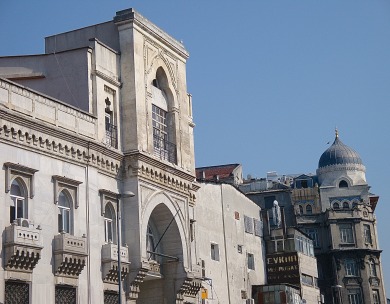 Foreground: lovely Garanti Bankası building. Background: Legacy Ottoman Hotel/Fourth Vakıf Hanı
Foreground: lovely Garanti Bankası building. Background: Legacy Ottoman Hotel/Fourth Vakıf Hanı
Eating
Eminönü has long been known for the cheap mackerel sandwiches on sale along the waterfront although the sad reality is that all the fish is imported from northern Europe rather than being caught by the local fishermen.
These days everything is far better organised and far more “touristy” than it used to be, with waiters in faux Ottoman costumes and the boats on which the fish are fried lit up at night like the Blackpool Illuminations. Regardless, it’s still a lot of fun to tuck into a sandwich, perhaps accompanied with some turşu (pickles) too. Long may it last since the authorities are itching to get rid of the last two such boats.
Facing the Ottoman Legacy Hotel you’ll find two competing purveyors of Turkish delight: Ali Muhiddin Hacı Bekir, which has been in the sweet business since 1777, and Hafız Mustafa, which has been selling it since 1864.
Pandeli. A beautiful turqoise-tiled space bove the main entrance to the Spice Bazaar. Only open for lunch. Tel: 0212-527 3909
Sleeping
Legacy Ottoman Hotel. Tel: 0212-526 6767
Orientbankhotel. Tel: 0212-252 1o10
Transport info
The waterfront at Eminönü is home to the piers for public ferries to Kadıköy and Üsküdar as well as up the Bosphorus. Services are operated by Şehir Hatları. Timetables can be found on https://www.sehirhatlari.istanbul/
A growing number of private cruise operators also tout cruises up the Bosphorus, some of them travelling only as far as the first Bosphorus Bridge at Ortaköy.
Nearby areas
Read more about Eminönü: THE EMINÖNÜ BACK DOUBLES
